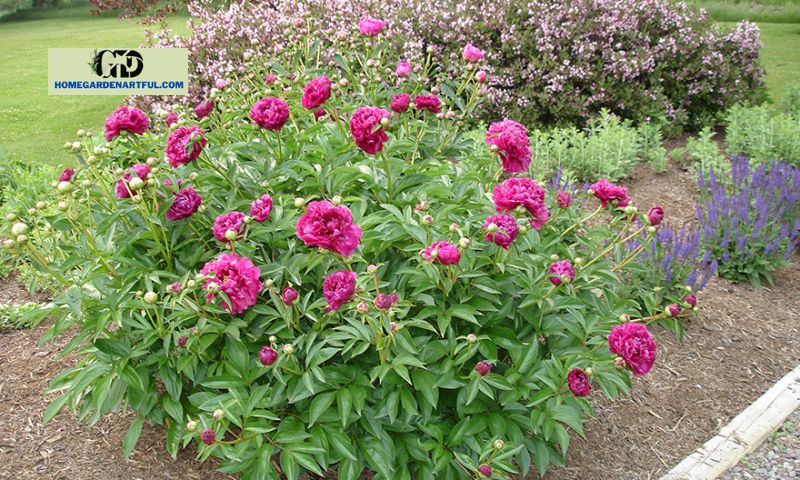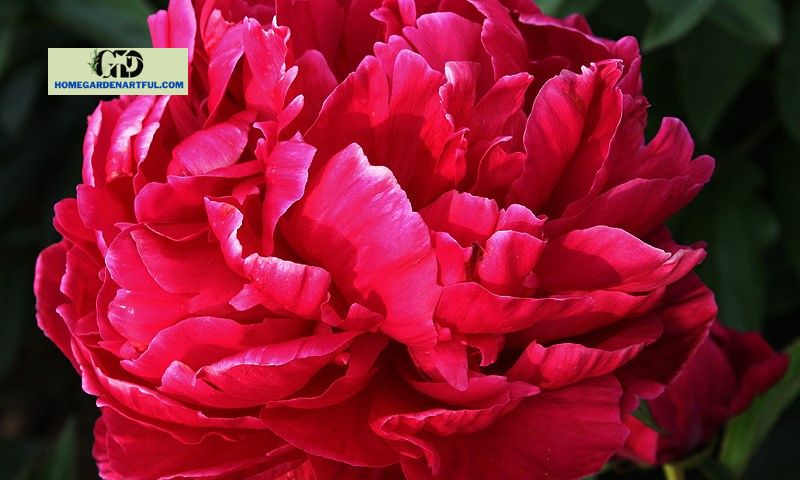One of the garden’s most striking and intensely colored peonies is the Karl Rosenfield Peony. Thankfully, they’re also really simple to grow and look lovely in your early summer garden.
The Karl Rosenfield peony has huge, deep-red, double flowers that are fluffy in texture. These hardy perennial plants have lustrous green foliage and reach heights of 32-38 inches. On mature plants, the big blooms can measure 6 to 7 inches in width and make excellent cut flowers for bouquets. The Karl Rosenfield Peony is a variety of Paeonia lactiflora that John Rosenfield developed in Nebraska and released in 1908.
At homegardenartful.com, learn how to grow Karl Rosenfield peony by reading on.
How much height can Karl Rosenfield peonies reach?

Karl Rosenfield peonies often grow to be between 32″ and 38″ tall, or about 3 feet tall. They are medium-sized perennial blooms that look like bushes for the majority of the year.
Karl Rosenfield peonies are an excellent flower to plant in your yard if you want to have big flowers and also have lovely shrub-like foliage in the summer.
When do the peonies of Karl Rosenfield bloom?
Depending on the temps and weather in your garden, Karl Rosenfield peonies often bloom around the middle to late spring.
They will blossom in the middle or late spring if you reside in a warmer climate. They may blossom in the early summer if you reside in a region with slightly lower temperatures. The use of well-drained soils and sufficient air circulation are crucial.
How Much Time Does a Karl Rosenfeld Peony Bloom?

Although they occasionally bloom for longer, Karl Rosenfield peonies normally bloom for 7–10 days. These herbaceous plants only have one bloom each year.
Karl Rosenfield peonies only bloom for a little more than a week, yet they remain attractive for the majority of the year. The Karl Rosenfield peony’s blooms eventually fade or are plucked, leaving only the plant’s foliage.
The foliage is green in the late summer and the beginning of fall, adding some much-needed color to your landscape.
The leaves become green and the plant appears to shrink throughout the winter when the plants have frozen over. After it dies for the winter, the leaves may turn brown, but frequently they do.
Do Karl Rosenfeld peonies require assistance?

Karl Rosenfield peonies occasionally require support because their stems aren’t always sturdy, especially when the flowers are fully open.
Early in the spring, when the well-drained soil has become again soft, you should offer support to the Karl Rosenfield peonies growing in your garden. The Karl Rosenfield peony will grow and thrive with assistance; strong stems will be produced, and the blossoms won’t droop toward the ground.
Use peony support rings or stakes.
Before the flowers bloom, tuck the peony support rings underneath the blossoms to prevent them from drooping to the ground. With careful positioning, you won’t be able to see the peonies right away because they can be carefully tied to a stake or held high with the peony support ring.
How is a bare-root Karl Rosenfield peony planted?
If at all feasible, plant a bare-root Karl Rosenfield peony as soon as the fall growth season begins. Peonies can be planted in the early spring, but depending on how the plant does, you might not see the blossoms bloom till the following spring.
Karl Rosenfield peonies don’t grow well after being transplanted, so pick your planting location wisely.
Dig a hole that is roughly twice as wide as the root, but not very deep, when planting a bare root of a Karl Rosenfield peony. Before planting peonies, moisten the plant root by soaking it in clean water while you are preparing the planting hole. Depending on how dry they are, peony roots can be immersed for anywhere between 20 minutes and 4 hours.
The creamy-pink “eyes” (the flower buds) of the Karl Rosenfield peony root should face the sky as you insert it into the hole. Put the potting soil that was removed back into the hole and cover the root with the earth’s surface.
The earth should be packed securely around the roots, but gently so as not to damage them. After planting, give the peony plenty of water.
Make sure to remove wasted flowers, and maintain a decent soil level, and water correctly to keep the blooms healthy.
Issues to watch out for
Avoid heavy nitrogen feeds because they encourage soft growth that is vulnerable to Karl Rosenfield Peony wilt, a type of botrytis that browns leave, stems, and flower buds. Itoh hybrids exhibit good resistance to this fungus, but it also helps to promote good air circulation around plants, cut back on old foliage by 15 cm in the fall completely remove it in the spring, and remove any sick stems straight once.
Planting too deeply is frequently the reason for a noticeable absence of blossoms. The crown’s buds should be barely below the soil’s surface. Do not cover the peony’ crowns when spreading a layer of mulch in remembrance of this. Another possibility is that they are not getting enough light; keep in mind that they bloom best in full sunlight.


